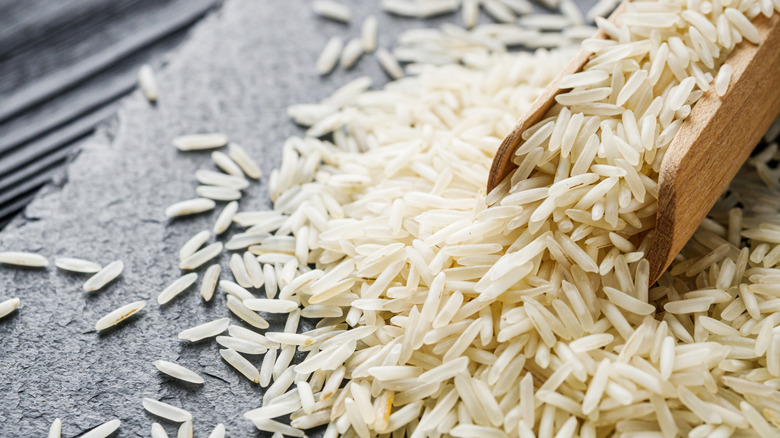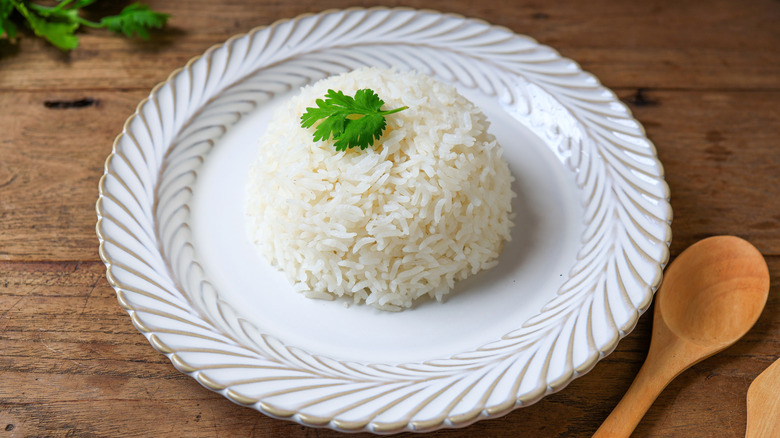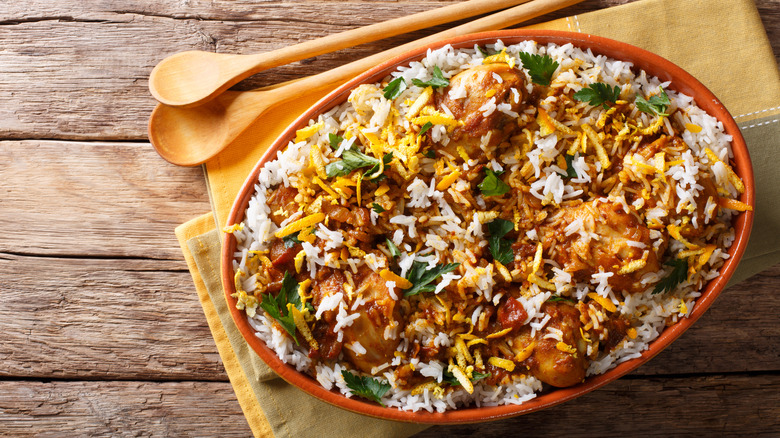Basmati Vs Jasmine Rice: What's The Difference?
There are two grains of rice in front of you. Both are white, meaning that the rice is processed to remove the bran and germ. Both are long-grain, meaning that each grain is about three to five times longer than it is wide. Can you tell which is basmati rice and which is jasmine?
For most people, that answer is probably a no. Among the many types of rice, the two seem similar. Both varieties are long-grain and are commonly white — although basmati rice can also be brown and jasmine can be found in brown, black, and even purple and red varieties — and as such, they often look nearly indistinguishable. However, the varieties have a lot that sets them apart, including their textures, flavors, preparations, and culinary applications. Even further, basmati and jasmine have their origins in two different regions.
Basmati rice is originally from the Indian subcontinent, most commonly found in northern India and Pakistan, while jasmine's home is Thailand, where the best version is called hom mali rice. These days, both varieties are also grown outside those parts of the world, and they aren't hard to find in grocery stores.
Despite visual similarity, expect different textures and tastes
The dissimilarity between the varieties extends beyond their roots and into their chemical makeup. Amylopectin and amylose are the two polysaccharide molecules found in starch, and the levels of each contribute to the clarity and texture of the rice variety. Jasmine rice has more amylopectin, while basmati has more amylose, and you'll be able to see the distinction even while the rice is still raw. The amylose-rich basmati rice will be translucent before it's cooked and firm and fluffy when it leaves the pot. The amylopectin levels in jasmine rice make it opaque and stickier once you cook it.
The taste and aroma of the rice varieties also diverge. Before your rice is even done cooking, you'll begin to smell a distinct scent — for jasmine rice, you'll probably get the aroma of its namesake flower (its Thai name, hom mali, means "fragrant of jasmine flowers"), while the basmati fragrance is a little earthier and nuttier. Basmati's nutty, toasty aroma carries over into its flavor profile, and jasmine rice will be slightly sweeter.
Learn the right way to prepare and present
Although the varieties are frequently substituted, the differing textures and tastes mean that jasmine and basmati are best suited to different preparations and dishes. Both varieties need to be rinsed before you cook them (which cleans the rice and washes off some extra starch), but basmati should also get a 30-minute soak, which helps it to cook more evenly. Jasmine rice doesn't need any soaking, and you also won't need as much water to cook it. Generally, the ratio is 1 cup of jasmine rice to 1 ¼ cups of water, while basmati's ratio can vary anywhere from 1:1.5 to 1:2, depending on how you're cooking rice and the texture you're looking for.
Basmati rice is common in Indian, South Asian, and Middle Eastern cuisines, and its fluffy texture means that it really soaks up flavor. Dishes like a Sindhi-style mutton biryani, where the rice is heavily flavored and mixed with meat, vegetables, and gravy, are ideal for its absorption abilities. Jasmine rice is integral to Thai, Vietnamese, Cambodian, and other South Asian cuisines. It works well with stir fry and curry or as a side of its own. The two can be substituted for each other, but for the highest quality flavor and texture, it's better to stick with what the recipe calls for — or to use the rice variety with which your dish shares a country of origin.



